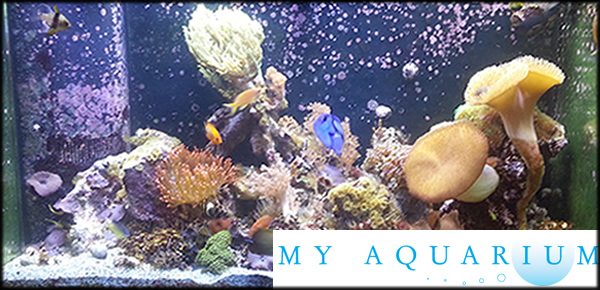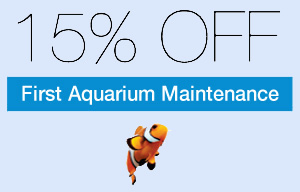Setup A SaltWater Fish Only With Live Rock Tank.
Saltwater aquariums come in three basic types: Fish only, fish only with live rock (FOWLR), and reef tanks. This article is a general introduction to setup the first two, reef tanks which are primarily gear towards cultivating invertebrates and live coral are much more advanced and aren't covered here.
As the term "fish only" would imply these tanks are designed for keeping only fish. You can add a few snails or crabs to help control algae but in general you won't have any invertebrates or coral. You can choose to keep peaceful fish or semi aggressive fish but it isn't wise to mix the two together. You need to do research on each species of fish you want to keep to decide if they should all be kept together.
Fish Only Saltwater Setup Without Live Rock: A fish only saltwater set up is the least expensive type of saltwater aquarium you can keep, it doesn't require any specific high output lighting or to much expensive equipment.
While the basic fish only tank may be a little less expensive than a fish only tank that utilizes live rock it will take more patience and work to start up. The live rock in a FOWLR tank assists in the nitrogen cycle but in a fish only aquarium there is far less room for bacteria to grow and reduce the nitrates, this will require you to wait longer before adding the fish and also require you to do far more water changes to keep the nitrate levels in line.
Fish Only With Live Rock (FOWLR) System: If your going to have a fish only saltwater tank, this is the way I suggest you do it. Live rock is not really alive, they call it that because it is composed of dead coral from coral reefs and it is capable of housing very beneficial organisms that it will come loaded with straight from the reef, live rock is the best form of natural biological filtration the saltwater aquarium can have. This live rock will drastically speed up your nitrogen cycle and help keep your nitrates lower allowing you to do fewer water changes for a healthier tank, it also gives the tank a much more natural look.
A FOWLR does cost a little more, you will need slightly better lighting to help the bacteria on the "live rock" and you will need the live rock itself which can be kind of expensive. A good rule of thumb for live rock is between 1 and 2 pounds of rock for each gallon of water and live rock can run as high as 6-8$ a pound. (can find it closer to 2.50 - 3 $ if you buy it used on sites like Craigslist)
Aquarium Nitrogen Cycle: All saltwater tanks need to be monitored regularly. A test kit to monitor the ammonia, nitrates, nitrites, and pH levels is cheap and easy to use. The tank will need to cycle once it is set up, during that cycle all ammonia and nitrites should be removed and converted to nitrates by bacteria. This cycle is good, ammonia and nitrites are very toxic and no fish should be added to the tank while either of these read anything but 0. Nitrates on the other hand are only mildly toxic and can be kept in check by periodic water changes.
Checking your nitrates regularly will give you an idea of how often you should be performing water changes. Your nitrates will naturally grow in a fish only tank when the ammonia turns into nitrites and the nitrites turn into nitrates. The target for nitrates is negotiable and the lower the better but in a fish only tank anything over 40 ppm is s to high. As this nitrate level builds up you will want to perform water changes, use a protein skimmer, or add macro algae to help lower them.
Fish Only Tank Equipment Needs: Regardless of weather or not you intend you add live rock to your system there are some definite equipment needs you will have for your fish only aquarium.
- Saltwater Mechanical Filters: There are several filter options you can use for your fish only aquarium but the most common and best choice for this type of system is a canister filter or a sump. If you want more enhanced filtration try getting a filter that is designed for a bigger tank than you have, or try using two canister filters at the same time. Another very viable filter option is using sump tank, this requires adding a separate tank to the display tank that will house beneficial algae in a refugium and a protein skimmer or other filtration.
- Water Pumps Or Powerheads: It is important to have good water circulation inside your saltwater aquarium. Water circulation helps oxygenate the water and allows all the water to be filtered rather than having dead spots. A simple powerhead or two is ideal to create the proper water flow in most aquariums, if your aquarium is very large you might need up to four or even more.
- Aquarium Heating: The aquarium temperature should be kept around 74 - 82 degrees Fahrenheit. A simple aquarium heater or two rated for your size tank should do just fine. If your lighting is very intense it may be necessary to run a chiller in the daytime hours. Chillers are very expensive, this is just one of the reasons I don't recommend unnecessary high intensity lighting like metal halides for a fish only tank.
- Aquarium Lighting: If you have a strictly fish only tank you will not need any lighting beyond what you want to see into the tank, you can run your basic low wattage fluorescent bulbs. If you have live rock you are going to need slightly more intense lighting but still nothing like you would need to grow coral. I would go for low to moderate wattage in power compact fluorescent bulbs, about 1 to 2 watts per gallon.
- Chemical Test Kits: Without corals you don't need to go quite as crazy with your test kits. I would recommend the standard Ammonia, Nitrite, Nitrate, and PH test kits, these typically can be purchased together in one set. After the initial set up and nitrogen cycle you don't really need to regularly test ammonia and nitrite unless there is a problem, but you should test nitrate and PH weekly to monitor water and water changes.
- Tank Additives And Water: If possible, you should use RO filtered water or distilled water to fill your tank. If you can't use these there are additives you can buy to mix with tap water that remove the chlorine, but these still aren't the best way to go. Regular additives such as calcium, magnesium, alkalinity, iodine, and trace elements really aren't necessary in a fish only tank unless you have coral.
- Live Rock And Sand Bed: It is best to keep a sand bed in any fish only aquarium, this sand bed is aesthetic and it also aids in biological filtration. If you are choosing to keep live rock it should cure with mechanical filtration for about 2 or 3 weeks until all ammonia and nitrite levels read zero before you should add any fish to the aquarium.
Picking out the right fish for your saltwater fish only aquarium.
You are free to choose any kind of community fish here you like but you have to be very careful you choose fish that are compatible together, if you keep a Clownfish in a tank with a lionfish the Clownfish is going to have a very bad time. Your fish should stay roughly the same size if there are any aggressive fish in the tank.
The types of fish most commonly kept in a fish only tank are the more aggressive varieties of fish such as Lionfish, Snappers, Puffers, Hawks, Squirrelfish, Triggerfish, Scorpionfish, as well as many large species.
It is generally not possible to keep these types of aggressive or large fish in a reef tank because they will eat or harm the coral and many carnivores are very messy eaters and will throw off the water parameters. To enjoy these types of fish many aquarists choose to have a fish only or FOWLR tank for these types of fish.
Though an aggressive tank is more common you are perfectly capable of making a fish only tank with peaceful or smaller species such as tangs, Bleenies, Clownfish, Gobies, Cardinalfish, Chromis, or other small peaceful species but it is important you don't mix the two groups.
Once your aquarium has cycled start stocking it with fish gradually over a few months. Add groups of species at a time, meaning if you intend to have more than one tang species add all the tangs at the same time. Add species in order from least aggressive to the most aggressive which will allow the more docile fish to feel at home first and likely reduce any aggression overall.


